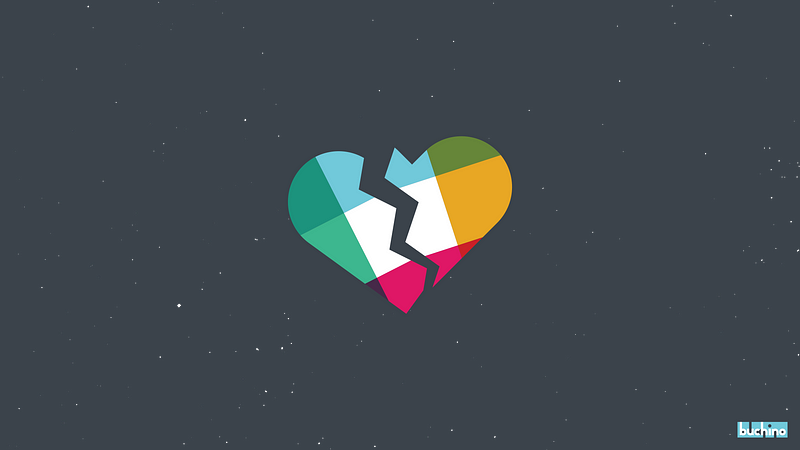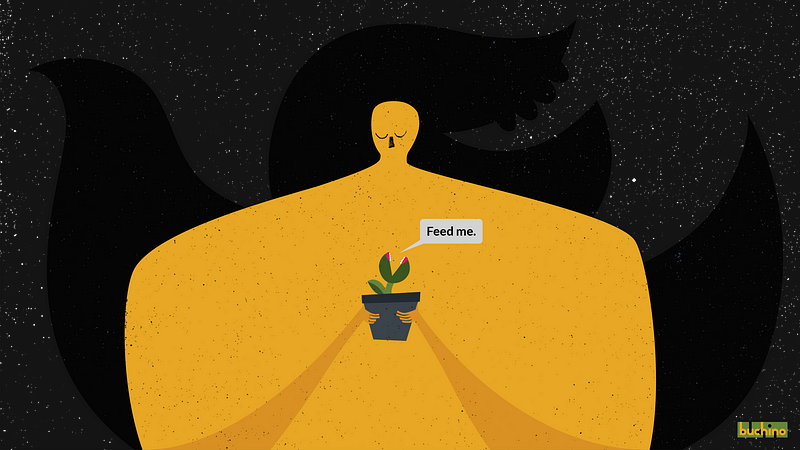Slack, I’m Breaking Up with You — Better People — Medium
Save article ToRead Archive Delete · Log in Log out
12 min read · View original · medium.com/better-people
Slack, I’m Breaking Up with You


“Revolutions have never lightened the burden of tyranny; they have only shifted it to another shoulder.”
— George Bernard Shaw
Hey there, Slack. This won’t be easy, but it’s for the best.
As you and I both know, things started out so wonderfully. Me with my exploding inbox, you with your (very sexy) ambition to make email obsolete.
Only, I don’t know if we’re so good for each other, after all. Or, more to the point, I don’t know if firing up a relationship with you ever really fixed what was broken in my other one to begin with.
Everyone knows email and I had our issues. Email started as a frisky exploration into a whole new world and quickly escalated to a scale beyond anyone’s expectations. Next thing I knew, email and I had not only put a ring on it, we’d bought a minivan and moved into a little place in the suburbs.
Was it rushed? Sure. I think if we’d known just how big the relationship was going to become, email and I would have set things up very differently from the start. Still, a commitment’s a commitment, and we’d settled into a routine we could at least call our own.
Then, out of nowhere, here you come riding into my life like a goddamned Clint Eastwood straight out of Bridges of Madison County. The personality! The colors! You were all promises, rose petals, and sex appeal. And SO much more responsive to my needs.
Soon, we were messaging every day. It wasn’t long until it was hard to think of a time I’d ever gotten things done without you.
And that, really, was where things began to unravel for us.
Because, even though you’re one of the most enjoyable pieces of software I’ve ever jumped into bed with, I’m not sure you’re THE one, and that seems to be more and more of what you’re demanding these days.
Slack, you’re asking for A LOT of my time
I may have been fooling myself when we were still in the honeymoon phase, but when there was all the talk of you killing email, I have to admit I thought it was the email problem you were attacking, not just the email platform.
Which is to say, I thought you were providing some relief from the torrential influx of messages, alerts, and notifications I was receiving on a daily basis. “Me + Slack = Fewer distractions and more productivity,” I thought at the time. I have to say, though, that I’ve since found it to be the opposite.
Like, WAY the opposite.
With you in my life, I’ve received exponentially more messages than I ever have before. And while it’s been awesome to have such a connection with you, it has been absolutely brutal on my productivity.
I understand that it’s my responsibility to set boundaries in all my relationships, but every software product comes with its own bias towards supporting some human tendencies over others, and I don’t think it’s arguable that you skew pretty hard towards “always on” over “dip in every so often”.
I’m finding that “always on” tendency to be a self-perpetuating feedback loop: the more everyone’s hanging out, the more conversations take place. The more conversations, the more everyone’s expected to participate. Lather, rinse, repeat.
This really lowers the bar for what’s considered message-worthy to begin with. Email may have had its flaws with its “FWD: FWD: CC: FWD You have to read this!!1!” jokes sent from distant family members, but my god in heaven do those sound like the halcyon days of tranquility compared to the Diet-Coke-and-Mentos-like explosion of cat gifs, bot feeds, and emoji mashups you’ve brought into my life.
Even your summaries of each week — the ones where you remind me about how our relationship is going — are all predicated on its volume of messages, which was kind of the opposite of what I thought you and I were all about.

Just because it’s fun to hang out at the water cooler at work, it doesn’t mean I want to work there.
Kind of the opposite, in fact.
Actually, speaking of getting things done…
You’re splitting my attention into a thousand tiny pieces
While it’s true that email was (and, despite your valiant efforts, still very much is) a barely-manageable firehose of to-do list items controlled by strangers, one of the few things that it did have going for it was that at least everything was in one place.
Trying to keep up with the manifold follow-up tasks from the manifold conversations in your manifold teams and channels requires a Skynet-like metapresence that is simply beyond me.
With you, the firehose problem has become a hydra-headed monster.
Everything is scattered, and the mental load that comes with it is real. Linda Stone calls this perpetual, shallow quasi-presence “continuous partial attention”, and this makes each conversational thread, almost by definition, a loose one.
This isn’t so bad in the real world, where conversations have nuance and substance and context. With you, though, everything has roughly the same weight, so I find myself having to mentally maintain tabs on all my chats, be they consequential or not.
Speaking of loose threads…
You’re actually making it HARDER to have a conversation
Back before we met, I had two primary modes of digitally communicating with people:
- Real Time
Some of the digital platforms I used were inherently “real time” (phone, Skype, IRC, Google Hangouts, etc.), where there was a built-in expectation of an immediate, rapid-fire conversation wherein everyone involved was more or less fully-present and participating. - Asynchronous
Conversely, there were other platforms that were inherently asynchronous (email, voicemail, iMessage, Twitter DMs, etc.), where there was no expectation of an immediate response, and people tended to send cogent feedback in their own time.
Then you came along, and rocked everyone’s world by introducing a conversational melting pot that is neither fully real time, nor fully asynchronous. You’re somewhere in between:
You’re asynchronish.
At first I thought this sounded delightful — it would be the best of both worlds! I was always free to drop someone a line, and if they were feeling chatty, a full-fledged conversation could simply spring up, with no need to switch platforms.
After getting to know you better, though, I’ve found that your “asynchronish” side is less impressive than I first thought. It leads to everyone having half-conversations all day long, with people frequently rotating through one slow-drip discussion after another, never needing to officially check out because “hey! it’s asynchronous!”
This leaves people spinning their wheels waiting for a response from someone who may or may not have already moved on to another discussion, with the problem only exacerbated by the fact that you don’t provide an indication as to whether that person is even currently in the same channel anymore, like by simply dimming their status dot.
Will they respond in 5 seconds or 5 hours? Who knows! It’s like getting caught in one of those support chats from hell with a Comcast rep who’s clearly trying to simultaneously jockey a dozen text conversations like some kind of bargain basement Bobby Fischer, except that it’s all day long and with everyone I know.
And, since you’re such a Swiss Army knife for conversation, it’s also often hard to get people to hop out of you to join a legitimate real time conversation, because it feels a bit too much like “booking a meeting” — since we can all Slack in Slack, why ever leave?
Actually, speaking of just that topic…
You’re turning my workdays into one long Franken-meeting
I think you and I can both agree that meetings are kind of the worst. And, on the surface, you do totally obviate the need for a ton of them. I can definitely think of many times in which a quick Slack whip-around has saved me from all kinds of interpersonal tedium. So thank you for that.
However, I’m wondering what the cost of it is. Specifically, I wonder if conducting business in an asynchronish environment simply turns every minute into an opportunity for conversation, essentially “meeting-izing” the entire workday.
All-day meetings every day of the week are substantially more “meetings” than the ones you’re saving me from.
There’s also a subtle side effect to asynchronish business, and that is its effect on the decision making process. When work gets done over email, there’s a general expectation of a response buffer of at least an hour or two. In you, though, people can convene and decide on anything at any time.
This is awesome for speeding up the tempo of company directives, but it also places a ton of pressure on everyone involved to maintain even MORE Slack omnipresence; if any discussion might lead to a decision being made, that provides a whole lot of incentive to be available for as many discussions as possible.
Even worse, those with the least on their plates can maintain the most Slack presence, which leads to the most gregariously unengaged representing the majority of the discussion base while penalizing those who are fully engaged in their “real” work.
More and more, you’re becoming something of a black hole for attention, sucking discourse and activity alike in with your massive (and very charming!) gravitational pull.
Speaking of black holes…
Lastly, you’re a bit on the possessive side
I will put this simply, Slack: not unlike Jake Gyllenhaal in Brokeback Mountain, I wish I knew how to quit you.
When I started feeling like our relationship was getting to be just a little too much, I decided to take a few days off. That was never a problem when I was with email — I’d just fire up a vacation autoresponder and be on my merry way.
With you, though, there’s apparently no option for deescalating our relationship outside of a few hours in “Do Not Disturb” mode. This means there’s no bigger-picture safety valve to make sure we’re not about to drive off a cliff hand-in-hand, like a socio-digital Thelma & Louise.


I belong to roughly 10 different Slack teams. People are very used to messaging me (directly or publicly) whether I’m online or not, so there’s a heavy social expectation for me to keep those conversational plates spinning on an ongoing basis, even if I’m signed out of all your clients.
I really don’t want to leave the people I care about hanging, but I haven’t seen any native way to let them know I may be gone for a while, and to perhaps try me elsewhere. This all seems a bit possessive on your part, whether you meant it to be or not — how do I take a vacation without taking you with me? How would you help me if I wound up in the hospital?
For better or for worse, you’ve gone from a novelty to a supernova in the blink of an eye. It’s only been two years, and many already act as if it’s impossible to remember what life was like before you came along.
You’ve become completely enmeshed in my social fabric, and I’m starting to worry about the effect you’re having on my friends, my colleagues, and even myself.
If you’re really on my side, you will not only let me experience life outside your embrace, you will even help me make it happen, trusting all the while that I will come back if it’s right. As they say, if you love something, let it go.
I’m sorry, but I need my space
Maybe you will say I’m afraid of commitment, but I’m just not interested in a relationship that seems to want to swallow up more and more of my time and attention, and demand that more and more of my interactions with other people go through you first.


I’ve stopped using you entirely over the past couple days, and it’s honestly been remarkable to see both how hard it’s been to disentangle from you from a social perspective, and how amazingly helpful doing so has been from a productivity one.
It’s hard to make this call, because I really do love so much about you. As a designer, I find you VERY attractive, both inside and out. Your user onboarding has always been world-class. Your copywriting even more so.
The question isn’t quality of design; you are stunningly well-designed in supporting the human tendencies you’re set up to support. I’m just not sure that those tendencies are ones I really want more of in my life right now. It seems that everyone’s social habits around using you are lagging pretty far behind your marvelous technical advancements.
If we’re going to get back together, I need to see you take the above on as a design problem. DND mode is a start, but there are so many other ways that design can help protect your users’ time and attention, both inside your interface and beyond.
Some ways have been alluded to, like dimming the dots of people who aren’t present, or allowing extended breaks via vacation autoresponders. I would also love to see not only how much time I’m spending with you, but how well that time was spent. Essentially, pursuing the UX maxim of “making it easier to do the better thing, and harder to do the worse.”
Because of your ethics, your commitment to user experience, and your astoundingly talented organization, no one is positioned to take the lead on helping our whole world communicate in a better — and saner — capacity quite like you are.
In the meantime, you can always reach me via email, or on Twitter at @SamuelHulick.
Illustrations by Michael Buchino • buchino.net
Words by Samuel Hulick • useronboard.com